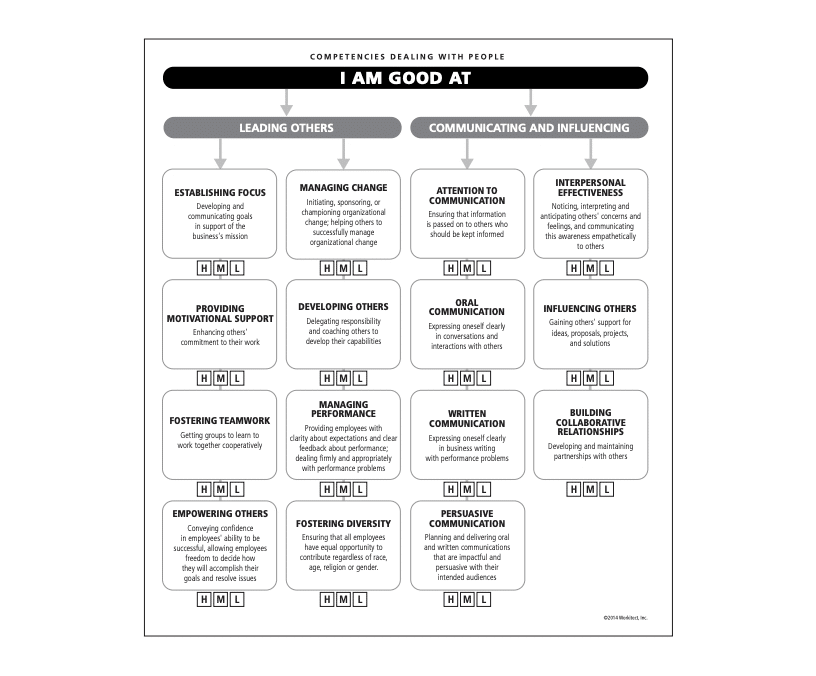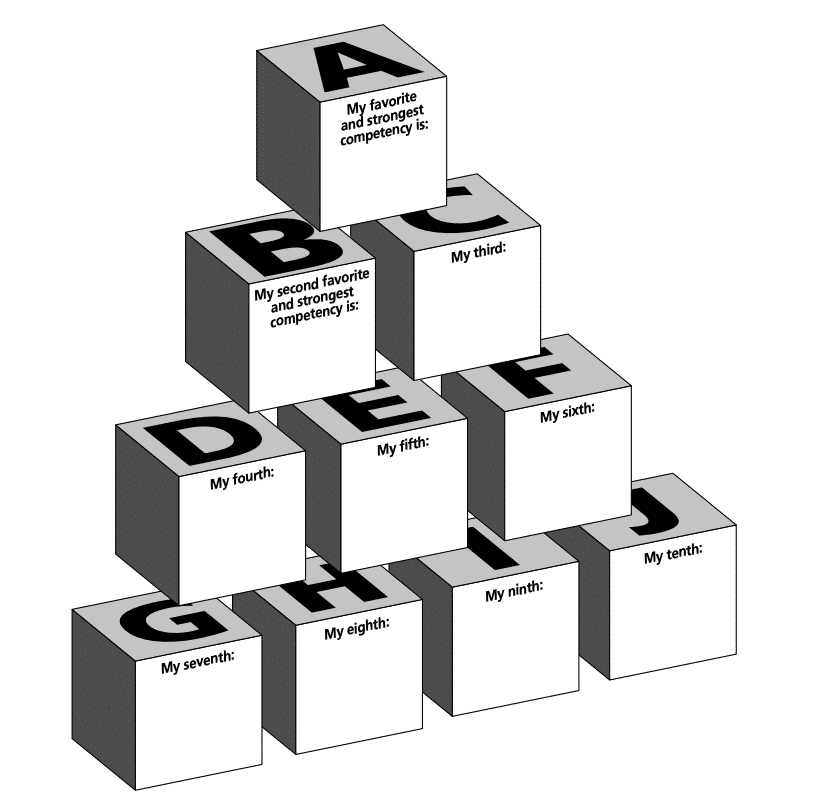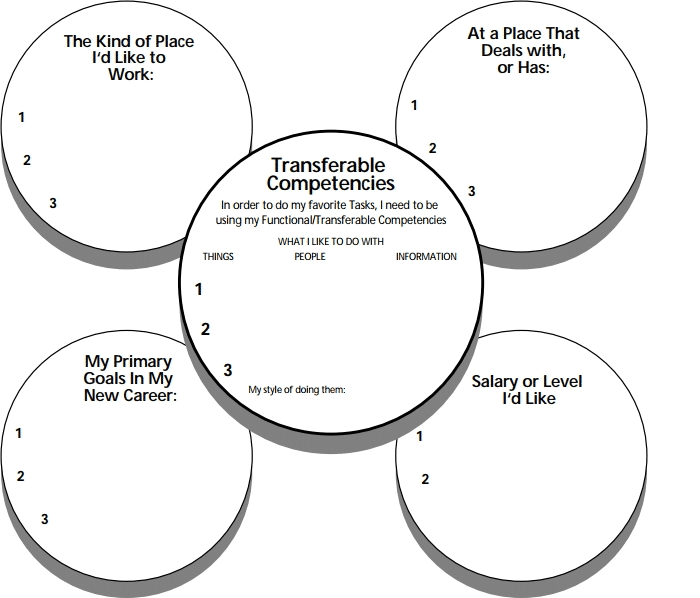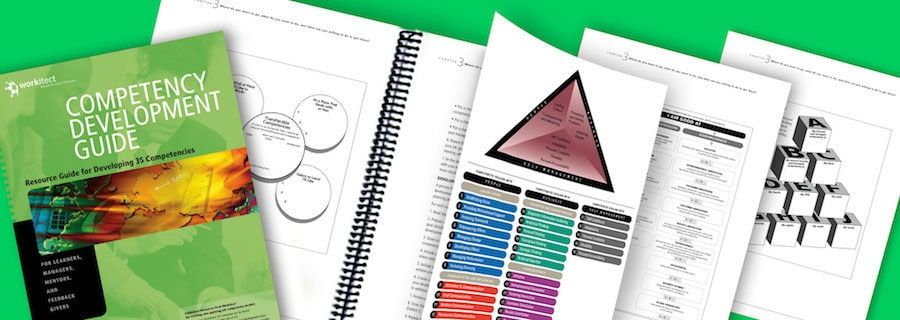Career Planning: Guide to Self-Assessment
From the Competency Development Guide, Chapter 3, Part 1. The Competency Development Guide is the 5th Edition of an easy-to-use, 280-page, 8.5″ x 11″ spiral bound handbook featuring actionable tips and resources for the development of 35 competencies.
In creating your career plan, before selecting specific competencies to develop, it may be helpful for you to spend some time thinking about your work life, personal life, and goals for the future. Your analysis should include an honest self-assessment of the aspects of your job that you find satisfying and those that are less satisfying, plus an assessment of your strengths and development needs. On the following pages are some forms to help you with this self-assessment. Full text and forms. A future post will describe: How to Select Competencies to target for Development and Developing Competency Goals
EXERCISE #1 – Self Ratings on 35 Competencies
The first set of forms list 35 different competencies in Workitect’s Competency Dictionary that are important in varying degrees to the accomplishment of different job functions. These competencies are grouped into three clusters related to: people, business and self-management. Competencies include personal characteristics, motives, self-concept, knowledge and behavioral skills. (For some positions, a list of competencies that are most critical to that specific job function has been developed. If that list is available for your position, you should refer to it.) Some competencies are easier to develop on the job or through training than other competencies. For example, improving your competency at written communications is easier than improving your self-confidence. Each competency is transferable to some degree to other positions.
The first step in the self-assessment is to go through the list of competencies and check the box (High-Medium-Low) that best reflects the degree to which you possess that competency. (There are three forms – the one below and one for business-related competencies and one for self-management competencies). Before doing so, consider any source of information that may be helpful in creating your career plan, such as performance appraisals, or feedback from a spouse, friends and other people who know you well. Also, be sure to ask, what do you like to do in your spare time? Another technique is to write stories about previous successes or accomplishments that can help uncover your inherent strengths and development needs. Start with just one story—an event or time when you really felt successful. It can be from anytime in your life, something from work or leisure. As you write, try to include the following in your story:
Another technique is to write stories about previous successes or accomplishments that can help uncover your inherent strengths and development needs. Start with just one story—an event or time when you really felt successful. It can be from anytime in your life, something from work or leisure. As you write, try to include the following in your story:
• What was your goal? What were you trying to accomplish?
• What kind of hurdles or restraints did you face?
• What you did, step by step.
• A description of the result—the accomplishment.
• Any measurement of the result.
Review the story and circle any word or phrase that reveals a competency in use. Then write several additional stories. Include a story about a time when you felt the end result was unsuccessful. What does it tell you about those competencies that can be further developed?
EXERCISE #2 – Strengths Pyramid
After completing your self-assessment of the 35 competencies, go to the next chart and identify your ten strongest competencies. These are the basic building blocks for success in your current job and for any future position. If you choose to alter your career plan, change careers or compete for another position, you may have to rearrange your current transferable competencies into new priorities or patterns.
It would be similar to the rearranging of building blocks that we used to do as a child. By changing the order of the building blocks, i.e. the order of importance of your competencies, you may have defined a new career goal for yourself.
EXERCISE #3 – Career Planning Diagram
Completing the circles on the Career Planning Diagram may lead to some additional insight regarding your career plans. The circle in the middle asks you to summarize your top three transferable competencies, a continuation of the thinking you did in Exercise 2.
In “The Kind of Place I’d Like to Work:” circle (upper left), consider a variety of choices such as the size of company, number of employees, kind of business, location, department, organizational climate, etc.
In the “At a Place That Deals With, or Has:” circle (upper right), complete the phrase while considering the type of product or service, the functional area, kind of customer, etc.
In the “My Primary Goals In My New Career:” circle (lower left), consider what you want to accomplish, how you want to accomplish “it”, the kind of team you want to be on, etc.
In the “Salary Or Level I’d Like” circle (lower right) consider the income range, starting pay level, and/or financial assistance you would need.
©2019, Workitect, Inc. All rights reserved.
Chapter 3, Part 1 can be downloaded here.
A future post will cover Part 2: How to Select Competencies to Target for Development and Developing Competency Goals.
COMPETENCY DEVELOPMENT GUIDE – the only Resource Guide for the Development of Competencies
Table of Contents for entire Competency Development Guide, including a sample of a competency development guide for one competency.
The Guide is available for individual purchase in print and PDF versions, and as a license for organization-wide use that includes rights for use of Workitect’s Competency Dictionary and a set of 35 Competency Interview Guides. 360 feedback instruments for assessment and development are also available.
 For additional information, contact me at 800-870-9490, edward.cripe@workitect.com,
For additional information, contact me at 800-870-9490, edward.cripe@workitect.com,
or complete this contact form.


Leave A Comment